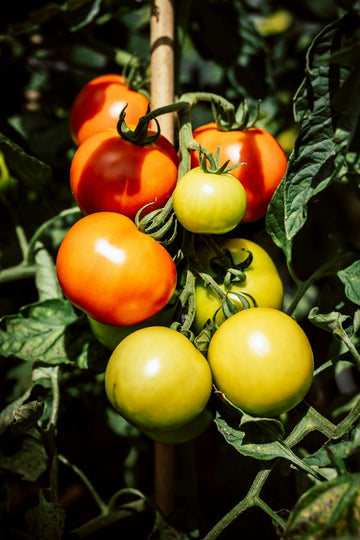Tomatoes, with their vibrant colors and rich flavors, are a staple ingredient in Indian cuisine. Growing them at home not only ensures a fresh supply for your culinary creations but also lets you experience the joy of nurturing your own produce. If you're in India and eager to cultivate tomatoes in your garden, balcony, or terrace, here's a detailed guide to help you get started.
1. Selecting the Right Varieties:
In India's diverse climate zones, it's crucial to choose tomato varieties that are well-suited to your region. Opt for heat-tolerant varieties such as "Roma," "Arka Rakshak," or "Pusa Ruby" for the plains and warmer regions, while varieties like "Pusa Early Dwarf" or "Pusa Hybrid 5" are suitable for cooler climates.

2. Timing and Location:
Timing is key when it comes to planting tomatoes in India. In most regions, tomatoes can be grown year-round, except during extreme weather conditions. Choose a location that receives ample sunlight, preferably 6-8 hours a day, and ensure good air circulation to prevent fungal diseases.

3. Soil Preparation:
Prepare the soil by mixing well-decomposed organic matter like compost or cow dung manure. This improves soil structure, fertility, and water retention capacity. Aim for a slightly acidic to neutral pH level (6.0-7.0) for optimal tomato growth.

4. Planting:
In warmer regions, sow tomato seeds directly into the prepared soil during the cooler months (October to December). For cooler regions, start seeds indoors 4-6 weeks before the last frost date and transplant seedlings outdoors once the weather warms up. Space the plants about 2-3 feet apart to allow for proper growth and airflow.

5. Watering and Mulching:
Tomatoes require consistent moisture, especially during the flowering and fruiting stages. Water deeply but infrequently to encourage deep root growth and prevent waterlogging. Mulch the soil with straw, dried leaves, or grass clippings to retain moisture, suppress weeds, and regulate soil temperature.

6. Support and Pruning:
Indeterminate tomato varieties, which continue to grow and produce fruit throughout the season, benefit from support structures like stakes or cages. Prune the lower branches and suckers (side shoots) regularly to promote better airflow, reduce disease risk, and focus energy on fruit production.

7. Fertilization:
Tomatoes are heavy feeders and require regular fertilization for optimal growth and fruit development. Use organic fertilizers like vermicompost or balanced NPK (nitrogen, phosphorus, potassium) formulations. Apply fertilizer every 3-4 weeks or as per the recommendations on the product label.

8. Pest and Disease Management:
Keep a close eye on your tomato plants for signs of common pests such as aphids, fruit borers, and leaf-miners. Employ natural predators like ladybugs or use organic pest control methods like neem oil spray or insecticidal soap. Prevent fungal diseases like early blight and powdery mildew by maintaining proper spacing, avoiding overhead watering, and applying copper-based fungicides preventively.

9. Harvesting:
Harvest tomatoes when they reach their mature size and color, depending on the variety. They should be firm yet slightly soft to the touch and have a rich color and aroma. Use a sharp knife or shears to cut the fruits from the vine, leaving a small portion of the stem attached. Harvest regularly to encourage continuous fruit production.

10. Enjoy the Fruits of Your Labor:
There's nothing quite like the satisfaction of harvesting homegrown tomatoes and incorporating them into your favorite dishes. From tangy chutneys to savory curries and refreshing salads, the possibilities are endless. Experiment with different recipes and savor the unparalleled flavor of your own organically grown tomatoes.

Conclusion:
Growing tomatoes at home is a rewarding endeavor that allows you to enjoy the freshest, most flavorful fruits while connecting with nature. By following these steps and adapting them to your local conditions, you can cultivate a bountiful harvest of tomatoes to enhance your culinary adventures and nourish your body and soul. So roll up your sleeves, dig into the soil, and embark on your tomato-growing journey today!






 At Palasa, we believe in the seamless fusion of nature, design and humanity.
At Palasa, we believe in the seamless fusion of nature, design and humanity.